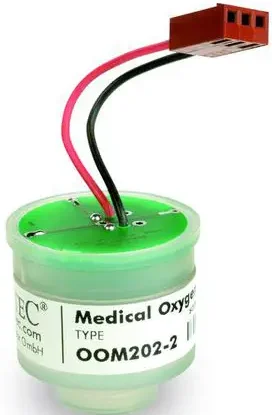Honeywell MOX Series and INQOX Medical Oxygen Sensors Instruction Manual

Honeywell MOX Series and INQOX Medical Oxygen Sensors

Warnings and Precautions
- It is the responsibility of the user to determine the suitability for use of the sensor
- Follow the instructions for use of the oxygen analyzer and for the replacement of oxygen sensor.
- To avoid cross infection please follow strictly the instructions of the oxygen analyzer manufacturer.
- Refer to the oxygen analyzer operation manual to determine any needed pre-operative checks.
- Sensor contains lead (Pb), lead oxide (PbO) and a concentrated potassium acetate/hydroxide solution (4mol/l and 1mol/l respectively) all of which are encapsulated by a housing. Lead and lead oxide are toxic and dangerous for the environment. Concentrated potassium hydroxide is corrosive. Do not open the housing or penetrate the permeable membrane. Do not touch a damaged sensor without protective gloves. In case of leakage avoid contact with eyes.
- The sensor is no suited for use in a magnetic resonance imaging (MRI) environment.
Indications for Use
The MOX series and INQOX Medical Oxygen Sensors are intended as oxygen-sensing components of an oxygen analyzer that measures oxygen concentration in breathing gas mixtures in the following applications:
- Sensing device for oxygen in control device of oxygen concentrates
- Sensing device for oxygen in medical ventilators
- Sensing device for oxygen in anesthesia equipment (not to be used with Xenon) – MOX sensors only
- Sensing device for oxygen in incubators
- Sensing device for continuous Positive airway Pressure (CPAP) – INQOX only
The use of these sensors is limited to system monitoring and by professional users. The sensors are not suited for breath by breath analysis.
Caution: Federal law (USA) restricts this device to sale by or on the order of a physician.
Instructions
The sensor should be replaced only by a professional user. Before insertion into the device, check the sensor for mechanical damages and for crystallization of salts on the housing – do not use a damaged sensor or a sensor with crystallization of salts outside. Follow the instructions for use of the oxygen analyzer for replacement of the sensor. Verify that the sensor can be properly attached to the mechanical and electrical connections of the oxygen analyzer. Calibrate the analyzer according to the instructions in the analyzer’s operation manual and verify proper gas readings. Oxygen analyzer readings in room air will typically be between 19% and 23% when calibrated in 100% oxygen or another calibration gas level required in accordance with the analyzer’s instructions. The sensor should be calibrated in regular intervals (see instructions for use of the analyzer). If calibration problems or unstable signals occur, the sensor must be replaced.
Technical Sensor Specifications:
The sensor meets the requirements of ISO 80601-2-55. For detailed technical specifications, please refer to the sensor’s Technical Datasheets (https://www.citytech.com).
Environmental specification
| Recommended storage temperature (Except MOX7) |
-10°C to +40°C. Short excursions to +50°C are allowed. |
| Operating temperature | -20°C to +50°C. Allow at least 60 minutes equilibration time after significant or rapid temperature changes. |
| Operating humidity | 0 – 99%RH non-condensing |
| Operating pressure | 500 to 2000 hPa |
| Warm-up time | <30 minutes after replacement of sensor. |
| Influence from anesthetic agents | Meets ISO 80601-2-55 requirements. Note: INQOX sensor is not suitable for use with anesthetic agents. |
Principles of Operation
The MOX series and INQOX Medical Oxygn Sensors are based on the principle of electro-galvanic sensors. They are constructed in plastic housing containing two electrodes – a precious metal based cathode and a lead anode immersed in a liquid electrolyte medium. Electrically the device resembles a very low voltage battery cell. A gas permeable membrane provides the interface to the gas sample. The oxygen gas that passes through the membrane is then reduced on the sensing electrode (cathode) and lead is oxidized on the anode. The generates an electrical current that is passed through a load resistor which results in an external electrical voltage signal that is proportional to the partial pressure of oxygen in the sample. The sensor signal is temperature dependent and these sensors provide temperature compensation via an internal thermistor/resistor network.
Cleaning / Disinfection:
The sensor membrane and the printed circuit board should not come into contact with disinfectant or cleaning agents. The other parts of the sensor can be disinfected by disinfectant wipes or with a surface disinfection agent. Follow the instructions of the producer of the disinfection materials.
Disposal:
The MOX series and INQOX Medical Oxygen Sensors contain lead (Pb) and should be disposed of in accordance with local regulations. Note: as these sensors are provided as components for oxygen analyzers, they fall outside the scope of the EU WEEE Directive 2012/19/EU.
Manufacturer:
Honeywell Healthcare Solutions GmbH
Alter Holzhafen 18
23966 Wismar, Germany